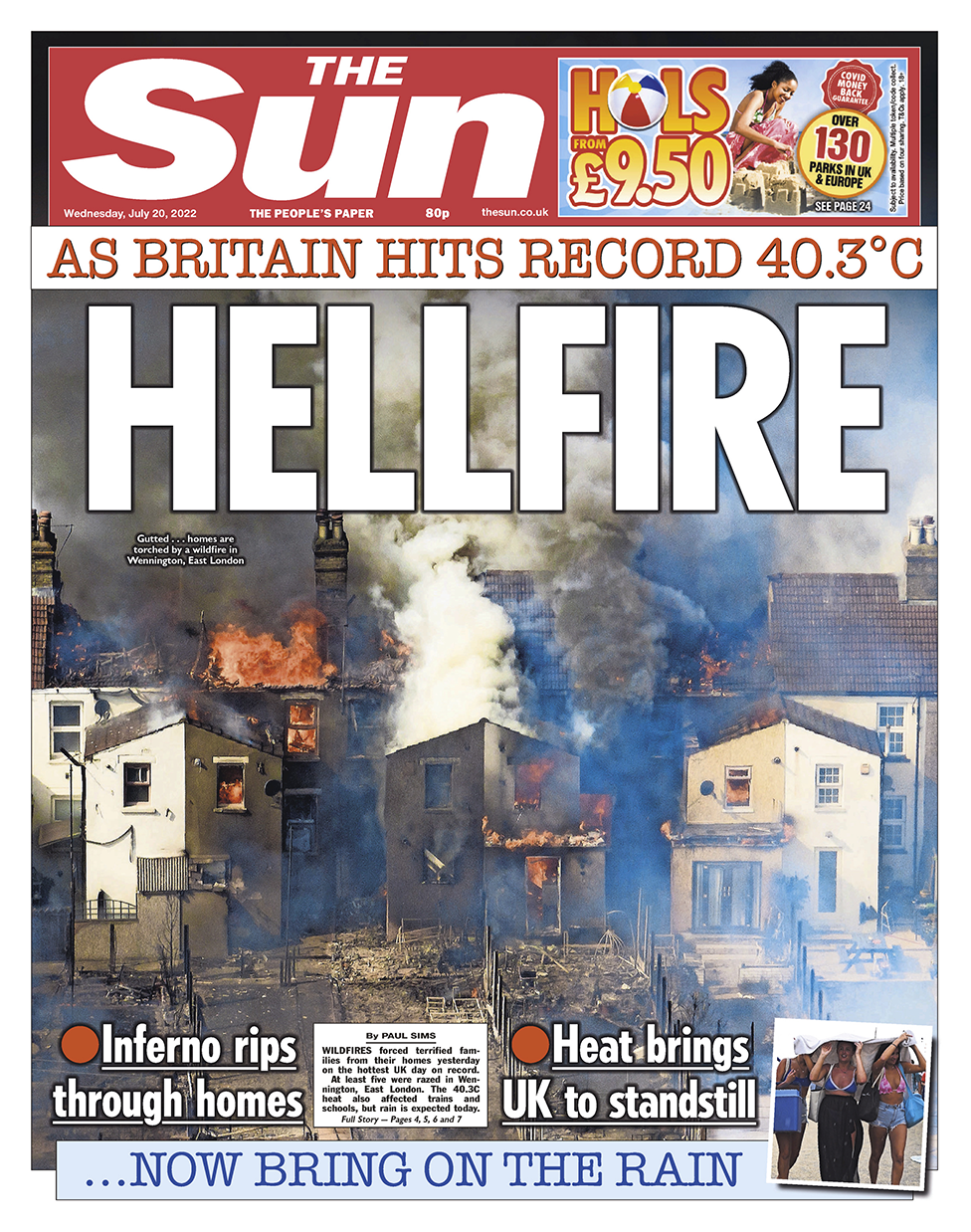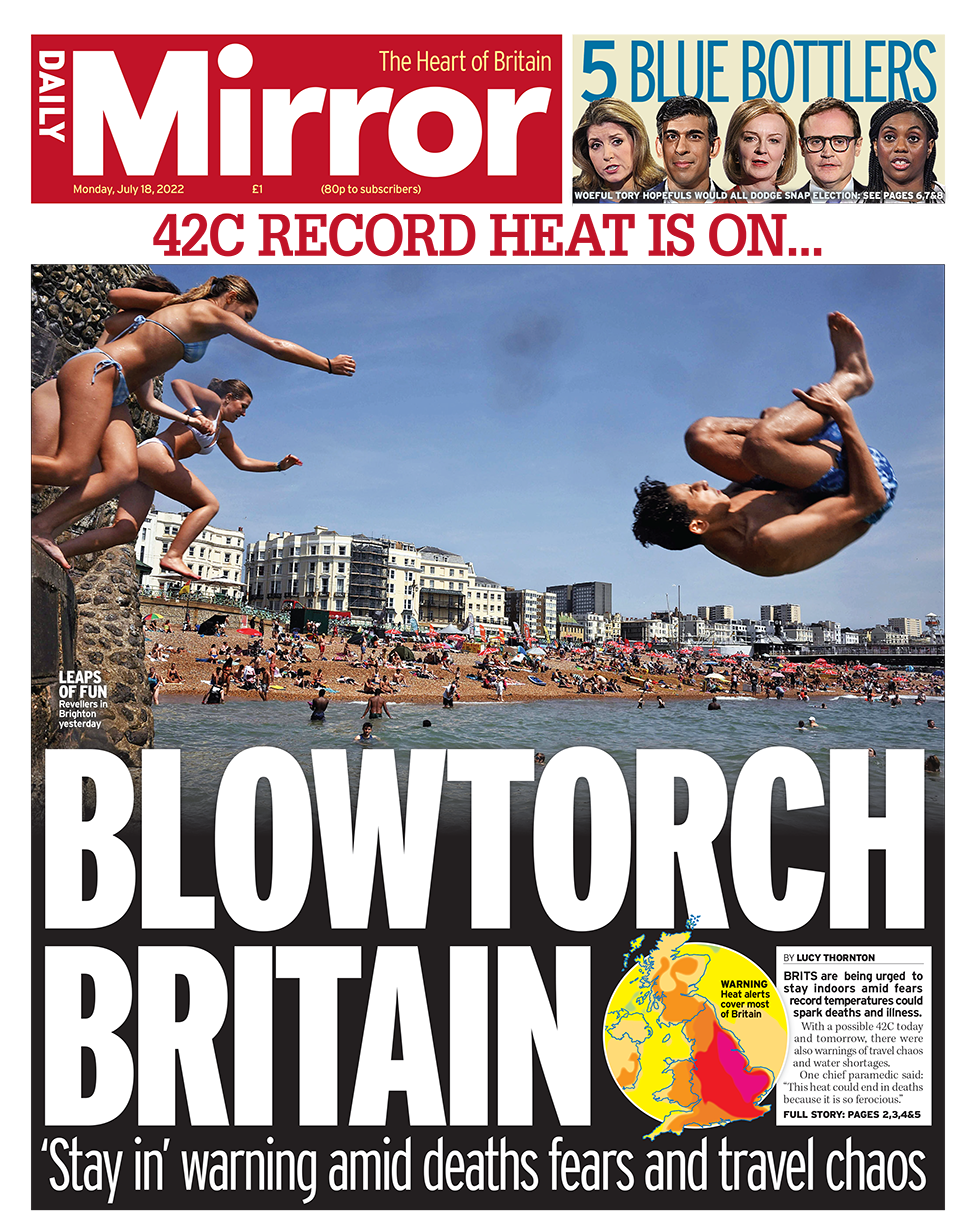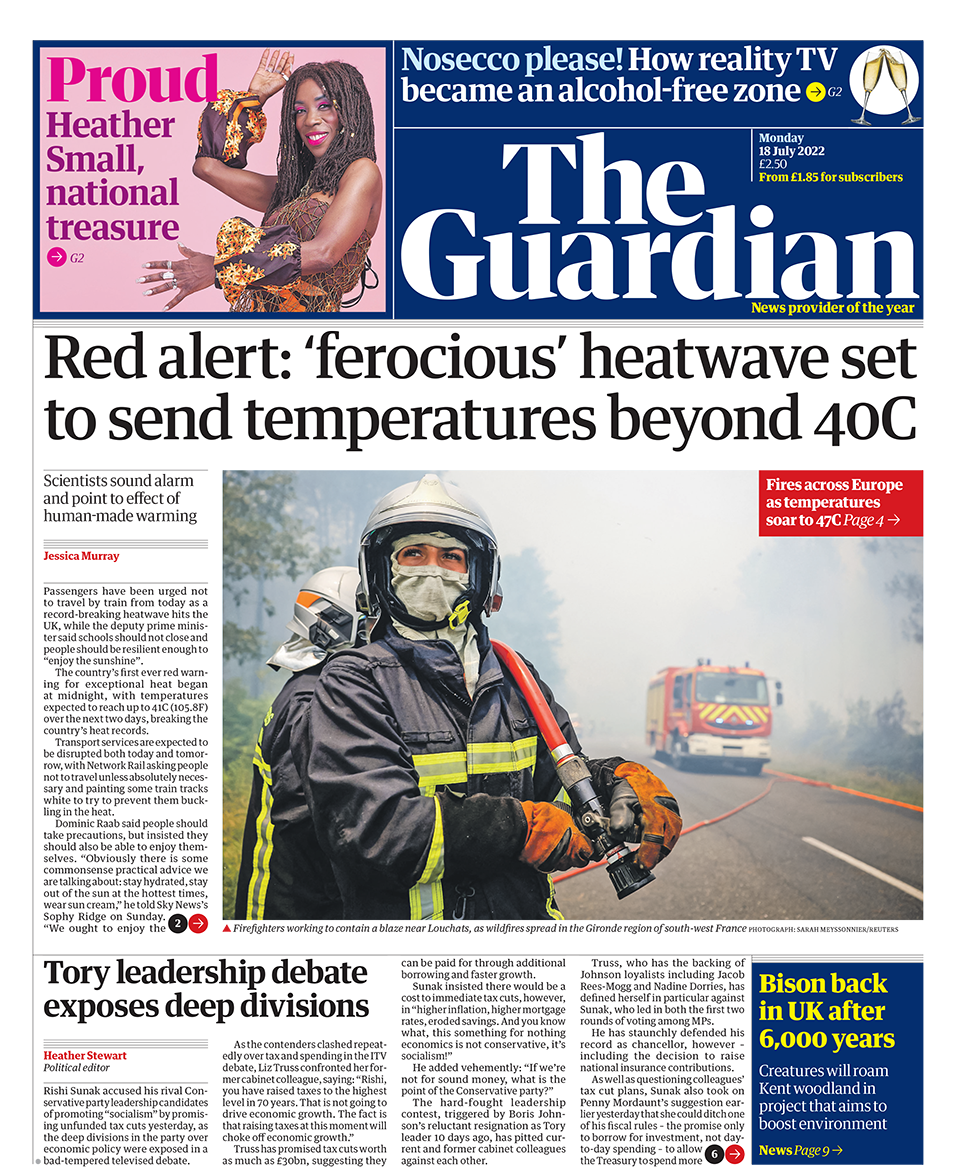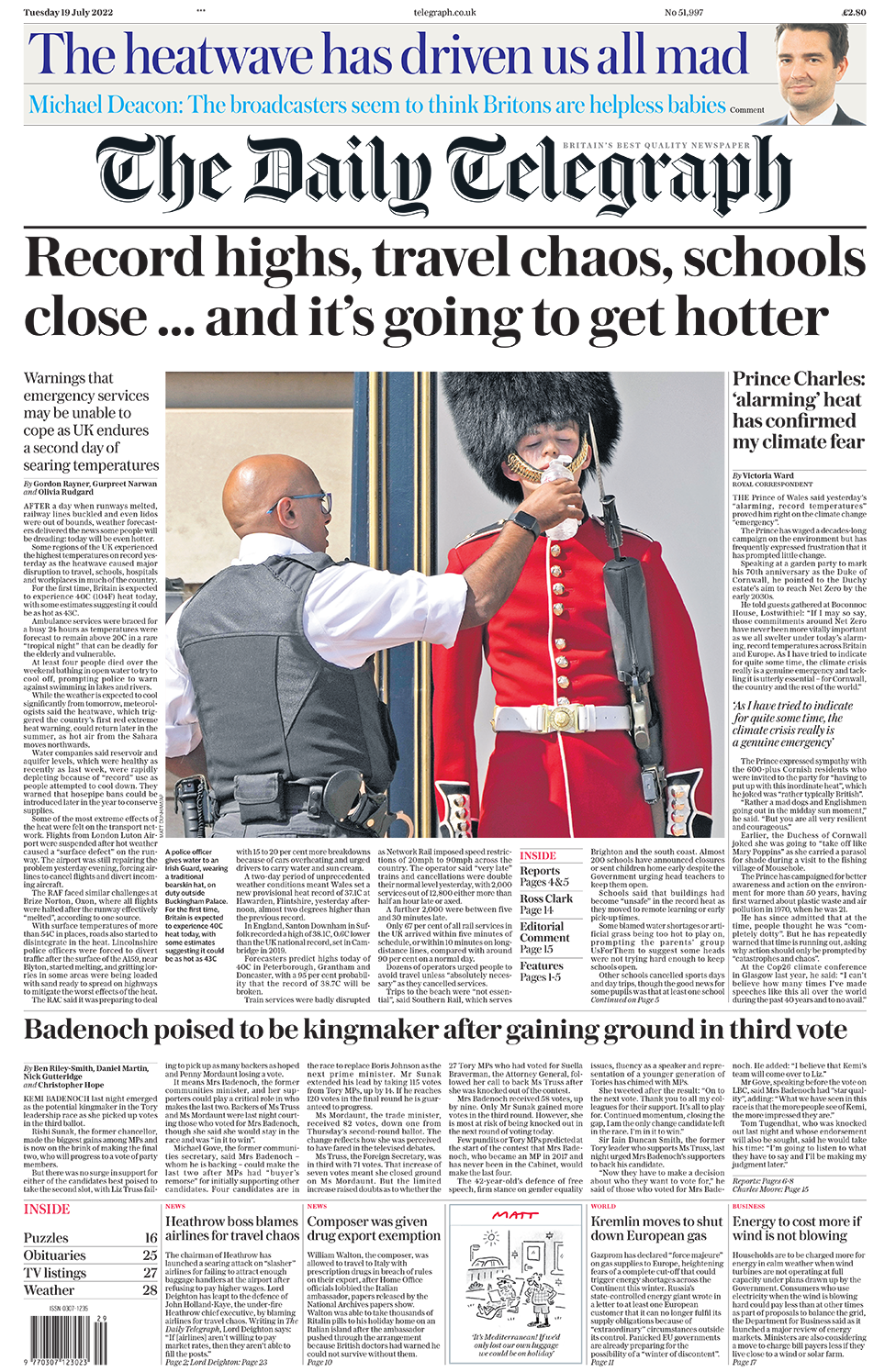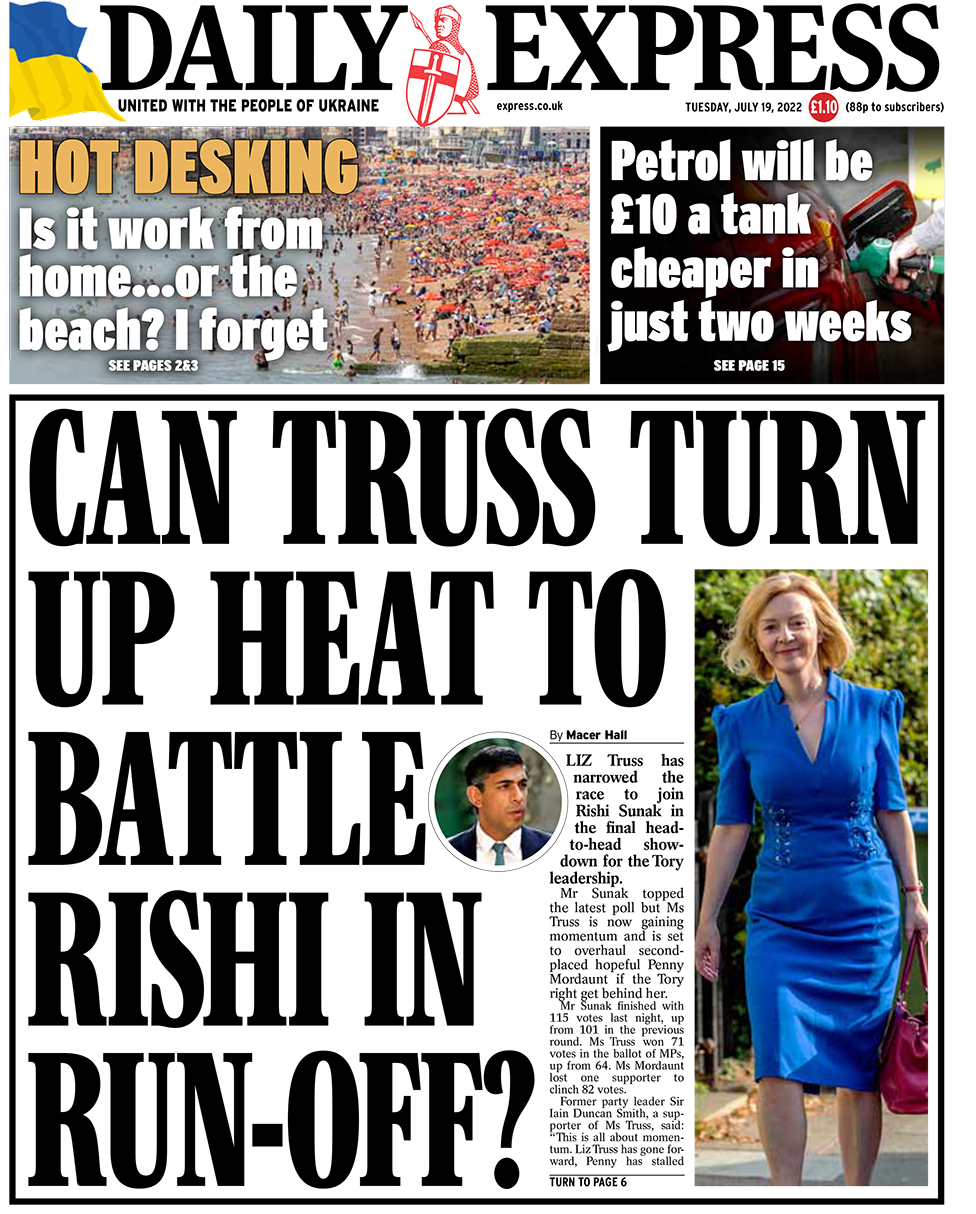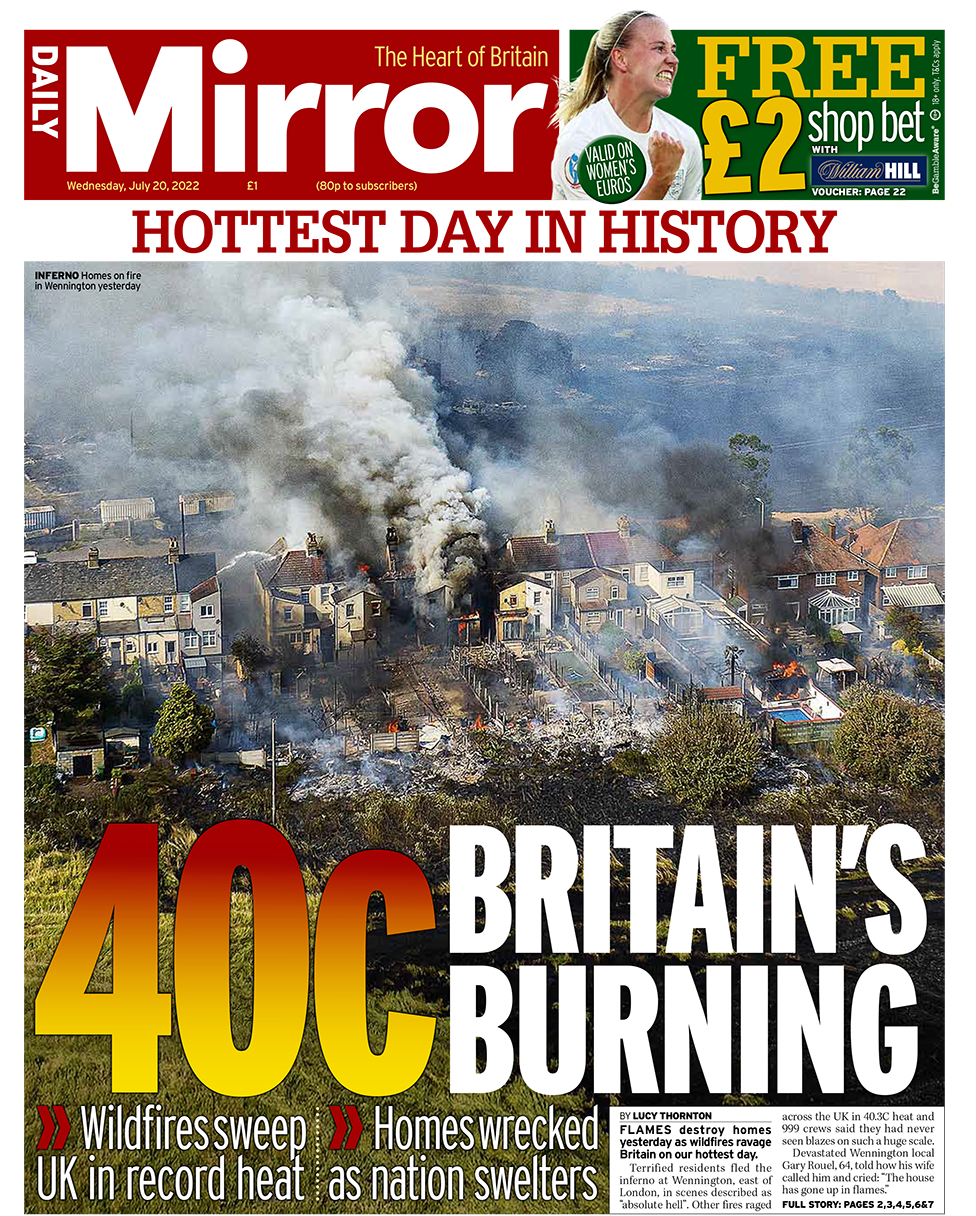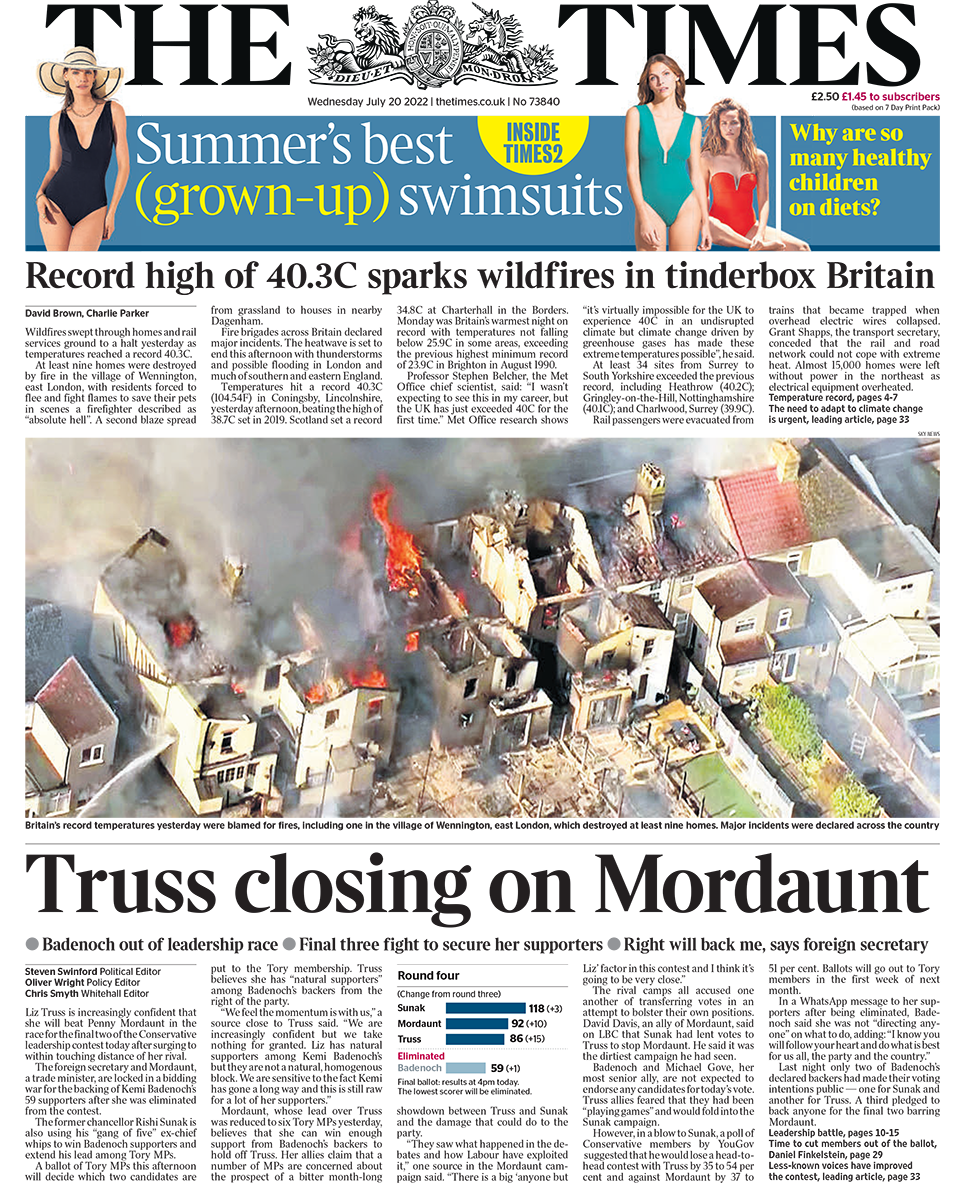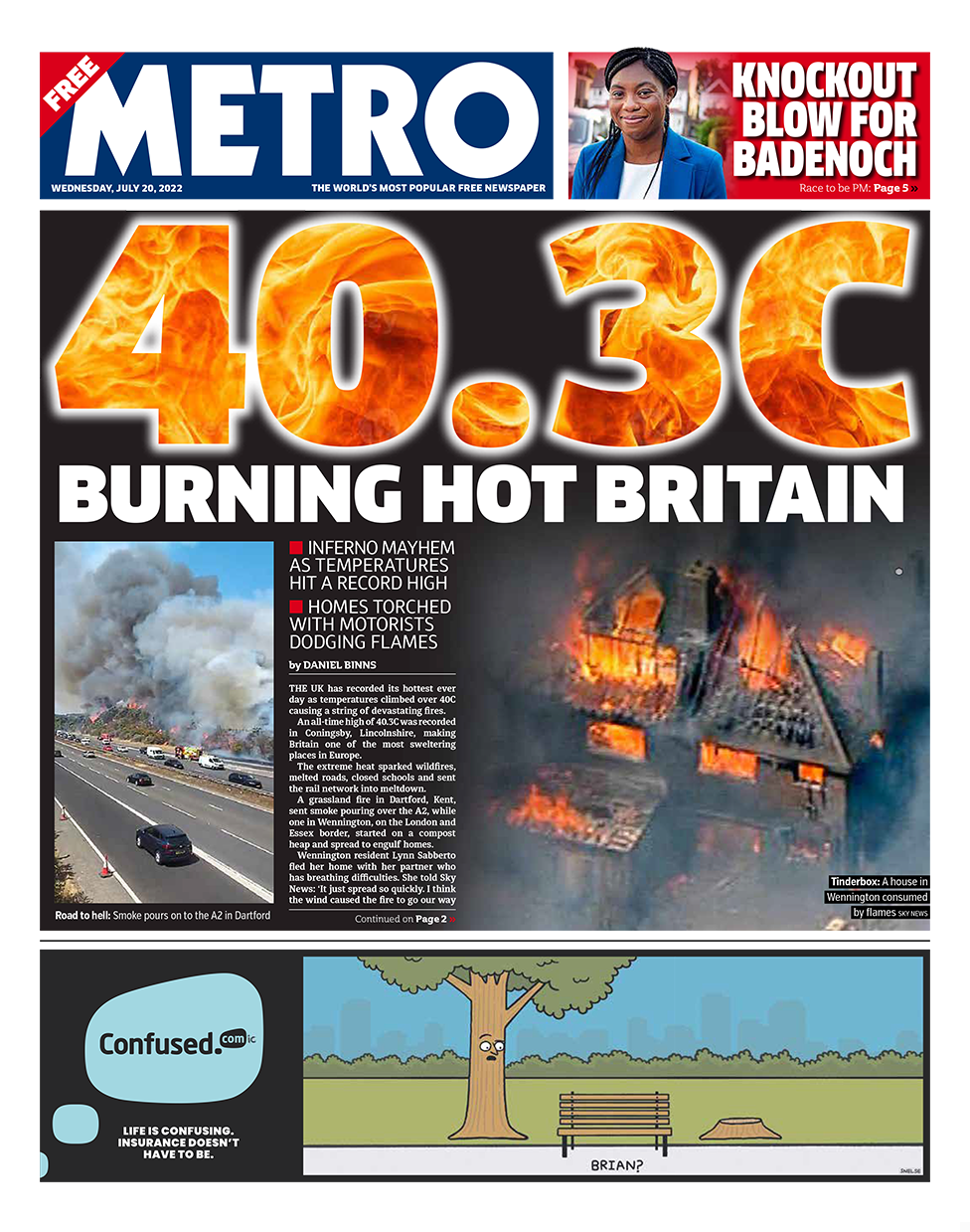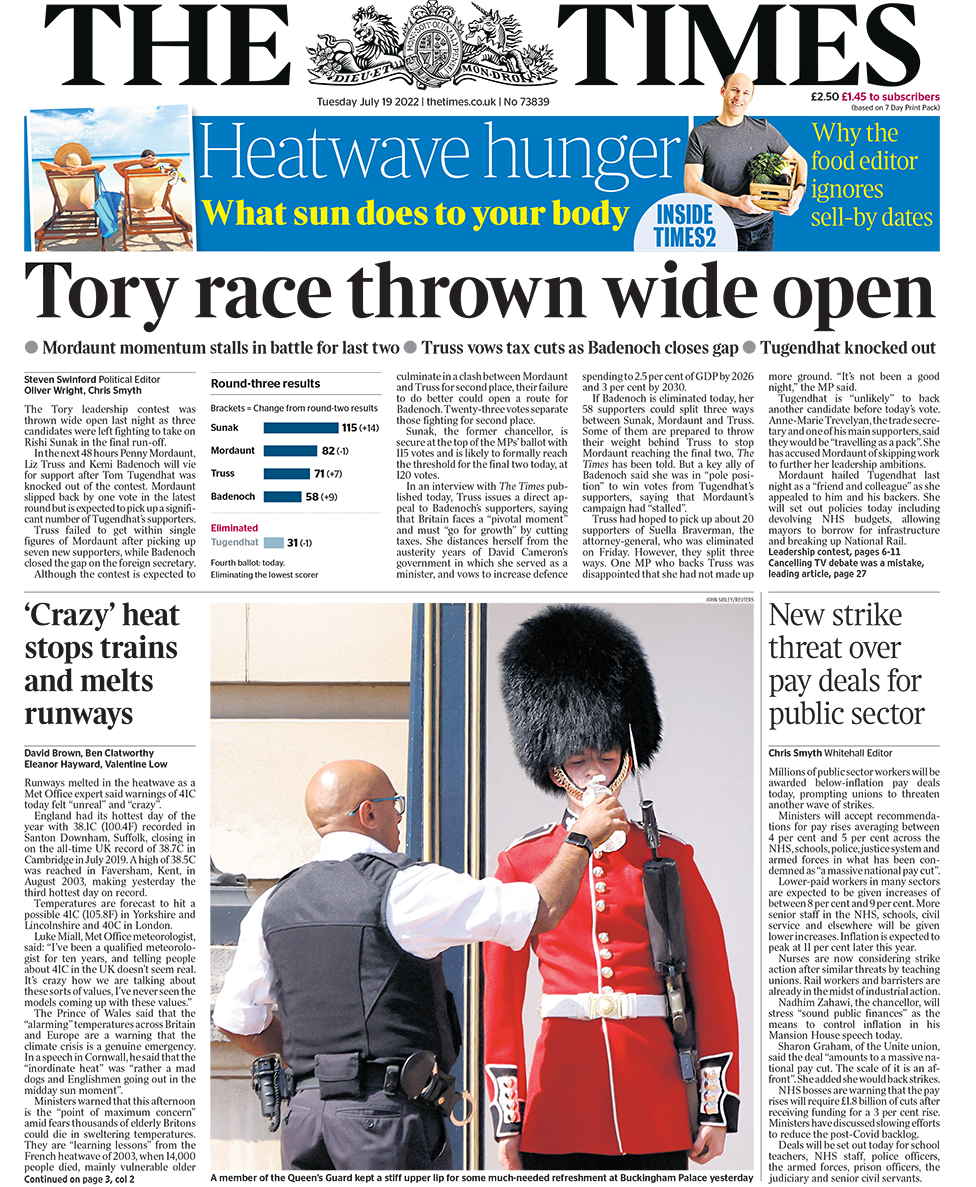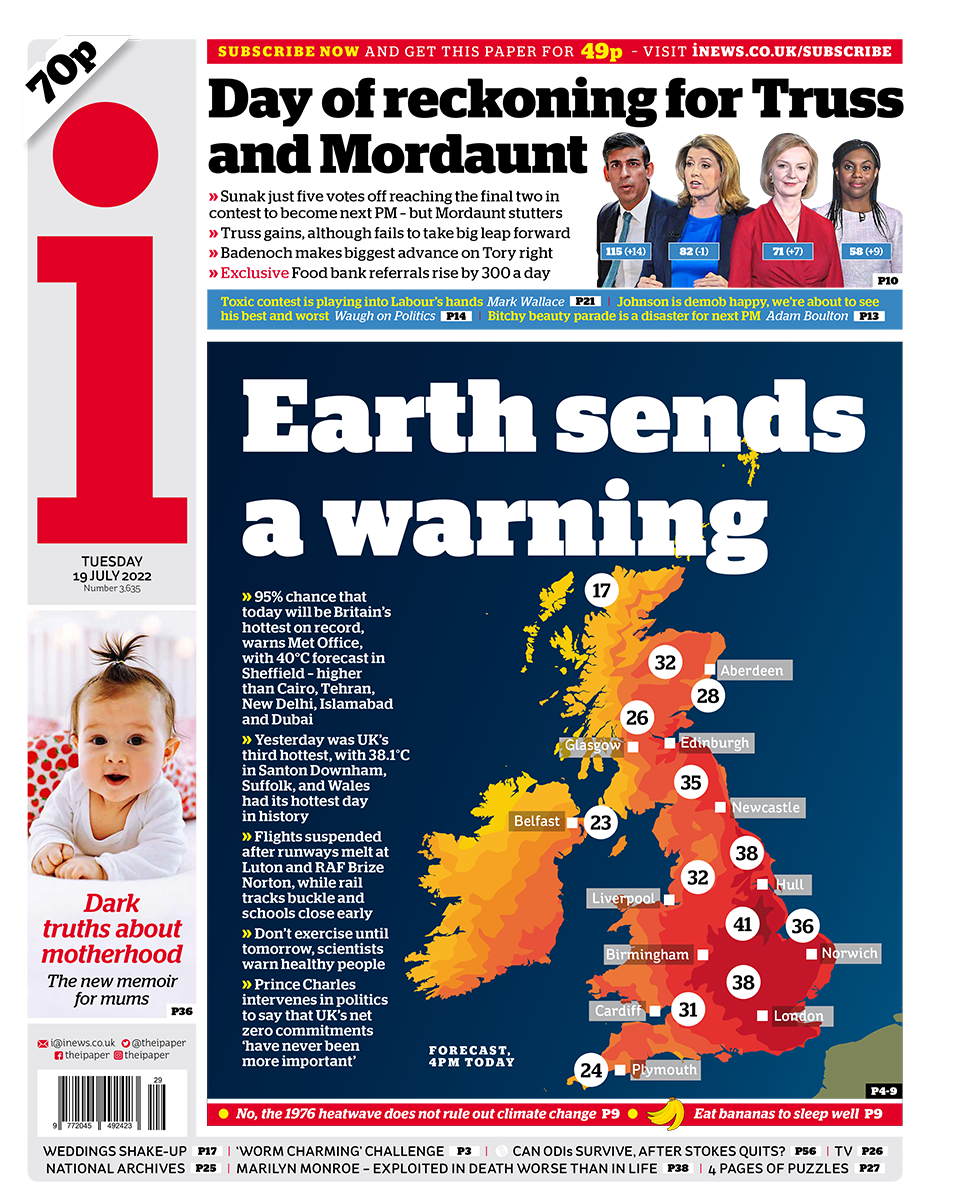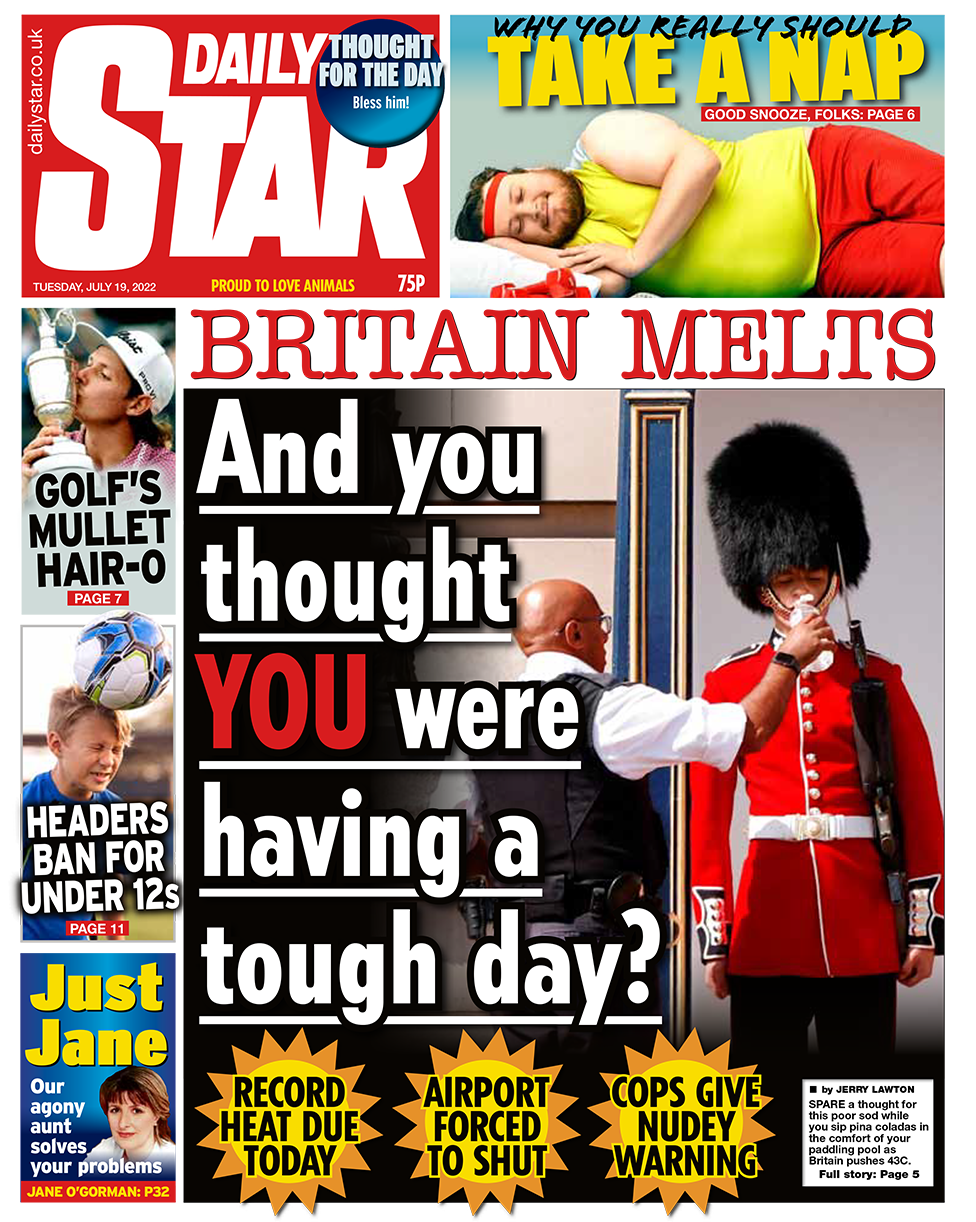
Media reaction: UK’s record-smashing 40C heatwave and climate change
Multiple Authors
07.19.22For the first time, the UK has hit temperatures of 40C, with Coningsby in Lincolnshire registering a high of 40.3C – smashing the previous record of 38.7C set in Cambridge Botanic Garden in 2019.
It comes after days of sweltering July heat, which has seen airport runways melt, schools close early and already-stretched hospitals pushed to their limit, among other impacts.
The record-breaking temperatures have prompted the UK government to release its first-ever level 4 heat-health alert, indicating “illness and death may occur among the fit and healthy, and not just in high-risk groups”.
The UK heatwave comes as many other parts of Europe continue to experience extreme temperatures, helping to trigger devastating wildfires in France, Portugal and Spain over recent days.
In this in-depth article, Carbon Brief examines the impacts of the record heat in the UK, the role of human-caused climate change and how the media has responded.
- How has the heatwave developed?
- What are the impacts of record-breaking heat in the UK?
- What role is climate change playing?
- How has the media responded?
- How has the extreme heat affected the rest of Europe?
How has the heatwave developed?
The UK has experienced very hot and dry conditions since early July. On Thursday 7 July, the Guardian reported that temperatures in England had reached 25C, with the “warm spell expected to continue through much of next week and the following weekend”.
The newspaper added that, according to long-range weather forecasts, “the mercury could touch 35C by mid-July”. (Read Carbon Brief’s explainer to learn more about how the UK’s unprecedented summer heat was forecast well ahead of time.)
On Friday 8 July, the UK government’s Health Security Agency and the Met Office issued a level 3 heat-health alert for London, as well as east and south-eastern England. (The Met Office describes a level 3 alert as a “heatwave action” alert, which “requires social and healthcare services to target specific actions at high-risk groups”.)
Over the weekend, temperatures continued to climb in the UK – as well as other parts of western Europe. Reuters reported that temperatures hit 43C in Spain on Sunday 10 July, with forecasters warning that the heatwave could last for several more days.
Associated Press, meanwhile, reported that Portugal’s government “declared an eight-day state of alert due to a heightened risk of wildfires, as the drought-stricken country prepares for a heatwave packing temperatures as high as 43C”. (They ended up reaching 47C – see below.)
By Monday 11 July, the UK government had extended its level 3 heat-health alert to cover the east midlands and south-west regions of England.
On the same day, the Met Office issued a “rare” amber weather warning for much of England and Wales. The warning said heat was expected to “build” throughout the week, with “exceptionally high temperatures possible” from Sunday onwards.
In a statement, the Met Office said its amber warning “highlight[ed] likely adverse health effects for the public, not just limited to those most vulnerable to extreme heat”.
⚠️⚠️Amber Weather Warning issued⚠️⚠️
— Met Office (@metoffice) July 11, 2022
This rare Extreme Heat warning covers much of England and parts of Wales 📈
Exceptionally high temperatures are possible from Sunday, lasting into early next week #heatwave 🌡️
Latest info 👉 https://t.co/QwDLMfRBfs
Stay #WeatherAware⚠️ pic.twitter.com/Ahe0nxK4aU
Later on Monday, senior government officials met for an emergency “Cobra” meeting inside 10 Downing Street to discuss the possibility of declaring a national emergency over the high temperatures expected from Sunday onwards, Sky News reported.
By Tuesday 12 July, the i newspaper was among publications reporting that temperatures could reach as high as 40C as the heatwave intensified after Sunday, according to Met Office forecasts. This would be far above the UK’s current temperature record of 38.7C, set in Cambridge Botanic Garden in 2019. The news was carried on the frontpage of the Daily Express.
And here’s the editorial in today’s Daily Express – and its frontcover pic.twitter.com/yWFn580E8s
— Leo Hickman (@LeoHickman) July 12, 2022
On Wednesday 13 July, the Met Office extended its amber weather warning to last until Tuesday 19 July, according to the Independent.
Later that day, London’s mayor Sadiq Khan triggered a severe weather emergency response in the capital in anticipation of extreme heat from Sunday onwards, the Guardian reported. This response required rough-sleeping services to conduct welfare checks and provide sun lotion and water to vulnerable people.
On Thursday 14 July, the Times spoke to the Met Office deputy chief meteorologist Tony Wardle, who said it was possible that UK temperatures could hit 40C as the heatwave intensified. He told the newspaper:
“Some models had been producing maximum temperatures in excess of 40C in parts of the UK over the coming weekend and beyond. These have highlighted the potential which exists in the developing weather situation, but it’s as yet uncertain if these values will materialise. Mid- to possibly locally high-30s remains the most likely scenario.”
But, by Friday morning, the Met Office issued its first-ever red warning for extreme heat. And a press release confirmed that, for the first time, 40C heat had been forecast in the UK.
The Met Office statement said “some weather models” were “producing a 70% chance of maximum temperatures in excess of 40C in isolated parts of the UK for the start of next week”.
Later that day, the UK Health Security Agency issued its first-ever level 4 heat-health alert. This level signifies a “national emergency” and is “reached when a heatwave is so severe and prolonged that its effects extend outside the health and social care system”.
“At this level, illness and death may occur among the fit and healthy, and not just in high-risk groups,” according to the Met Office.
On Saturday 16 July, government officials held another Cobra crisis meeting to discuss the national heatwave emergency.
However, the outgoing UK prime minister Boris Johnson “skipped” this meeting – “apparently to host a party at his luxury Chequers retreat”, according to the Independent. The story made the frontpage of the Sunday Mirror with the headline: “Boris’s heatrave.”
On Sunday, the Met Office raised its heatwave forecast, suggesting that there was a 90% chance the UK would set a new temperature record on Monday 17 or Tuesday 18 July, and a 60% chance of reaching 40C, the Financial Times reported.
On Monday, temperatures soared across much of the UK, reaching a maximum of 38.1C in Santon Downham, a village in Suffolk, eastern England.
Here are the top temperatures recorded across the UK on Monday 👇#heatwave2022 #heatwave pic.twitter.com/irazHtAI15
— Met Office (@metoffice) July 18, 2022
Monday also saw Wales set a new provisional national temperature record – after Hawarden, a village in north Wales, reached 37.1C.
This is almost 2C above the previous temperature record of 35.2C, recorded in the same village on 2 August 1990, according to the Met Office.
1600 UPDATE: Hawarden in Flintshire has now provisionally reached 37.1°C
— Met Office (@metoffice) July 18, 2022
🌡️ This is the highest air temperature ever recorded in #Wales #Heatwave2022 #heatwave #hottestdayoftheyear pic.twitter.com/QjkVL9YYrV
Overnight, the UK provisionally recorded its hottest night on record, with temperatures staying as high as 25C in some places. (This exceeds the previous highest daily minimum record of 23.9C, recorded in Brighton on 3 August 1990, according to the Met Office.)
And, by Tuesday morning, temperatures were already rising rapidly once more. According to the Met Office, temperatures had reached 35.1C by 10am at Kew Gardens, the botanical landmark found in west London.
A provisional new UK temperature record was set before noon, when Charlwood, a village in Surrey, southern England, reached 39.1C.
Just over an hour later at 12.50pm, the UK recorded temperatures above 40C for the first time since records began, when Heathrow Airport near London reached 40.2C.
By 4pm, four further sites had recorded provisional temperatures at or above 40C, with the highest clocking in at 40.3C at Coningsby in Lincolnshire.
In total, dozens of weather stations reached maximum temperatures above the previous record of 38.7C.
Scotland also set a provisional record high temperature – with 34.8C registered at Charterhall in the Scottish Borders, shattering the previous record of 32.9C in August 2003 by almost 2C.
What are the impacts of the record-breaking heat in the UK?
The UK Health Security Agency’s (UKHSA) level 4 alert for heat was the first time the agency had done so since the alert system was established in the 2004 Heatwave Plan for England. BBC News reported that the UK government is treating the heatwave as a “national emergency”.
In a UKHSA press release, UK Met Office chief executive Prof Penny Endersby said:
“In this country we’re used to treating a hot spell as a chance to go and play in in [sic] the sun. This is not that sort of weather.”
The NHS page on coping with hot weather notes that the main health risks posed by heatwaves are dehydration, overheating, heat exhaustion and heatstroke. It also lists some groups most vulnerable to heatwaves, including older people, those living on their own, people with long-term illnesses (including some types of mental-health conditions) and people who spend much of their time outside.
The i newspaper added that “rising temperatures will result in more violent assaults, suicides and thousands of excess deaths”, as well as “a rise in accidents such as car crashes and drownings”. The Daily Telegraph noted that there have been “a number of fatalities in water-related incidents during the heatwave” as people sought open water to cool off.
Meanwhile, Network Rail warned passengers to travel “only if necessary” on Monday and Tuesday due to “high likelihood of cancellations, delays and last-minute alterations”. BBC News reported that trains would be travelling at slower speeds to reduce the stress placed on already overheated rails.
Bloomberg reported that Transport for London ridership was down nearly 20% on Monday as compared to the previous week, adding that “the few commuters who braved the heat of London’s Underground transport system…had to endure temperatures deemed too hot to safely transport cattle”.
“Melting” of a section of Luton Airport’s runway in the heat of Monday afternoon resulted in suspended flights, reported the Guardian. All incoming and outgoing flights were suspended shortly after 3pm for around three hours, reported Sky News.
A separate piece on BBC News highlighted some of the business disruptions due to the heat. The Victoria and Albert Museum and the British Museum both announced partial closures due to unsafe temperatures in some galleries. Despite government-issued guidance on keeping schools open, “some schools have closed early – or chose not to open at all”, it said. London’s Hammersmith Bridge was partially wrapped in aluminium foil in an attempt to keep it from overheating.
Also in London, the Metro reported that the London Fire Brigade declared a “major incident” on Tuesday 18 July as crews tackled multiple fires across the city. It added that “several homes on the edge of the capital were destroyed after a grassfire broke out and spread wildly out of control”.
The GMB trade union “has called on the government to introduce a limit on how high the temperature can be in workplaces”, asking for an upper limit of 25C, reported the Independent. The paper added that “employers do have a legal obligation to ensure that the temperature in the workplace is ‘reasonable’, as outlined by the Workplace (Health, Safety and Welfare) Regulations 1992”.
In its liveblog on the extreme heat, the New York Times wrote that the UK is “unprepared for such extremes”, saying the heatwave had made the country take an “involuntary siesta”. Another entry noted that Brits are “flock[ing] to the sea”, with hotels in Brighton “experienc[ing] a big uptick in bookings”.
The Washington Post reported that Showcase Cinemas was offering free tickets to redheaded people on Monday and Tuesday, with the cinema explaining that it was because “redheads are often more vulnerable than most to the sun’s rays”.
An article in the New York Times cited a 2021 report from the UK Department for Business Energy and Industrial Strategy that estimated that under 5% of homes in the UK have air conditioning.
A Financial Times column, referencing the same report, noted that “around 20% of London homes will need air conditioning” by 2035, with that number rising to half by 2075. It warned that adding new AC units “will have an emissions impact to match”. The column continued:
“AC and fans already account for around 10% of the world’s electricity consumption. And they are particularly challenging for electricity grids because demand surges on hot days – often threatening blackouts if the grid can’t keep up.”
What role is climate change playing?
“This is not normal – climate change is making this heatwave worse,” Prof Richard Betts, head of climate impacts research at the Met Office Hadley Centre and University of Exeter, explained to the BBC Breakfast show this week, adding that the UK is “not set up for high temperatures”.
In separate quotes, Betts explained that while “wind patterns bringing the hot air up from over Spain [to the UK] could have happened without climate change…this is all happening in a world which has already warmed by nearly 1.3C”. This means, he added, that “when heatwaves happen they are more severe than they would have been without human influence on climate”.
The latest climate science report from the Intergovernmental Panel on Climate Change (IPCC), published in August 2021, concluded that it is virtually certain that “the frequency and intensity of hot extremes (including heatwaves) have increased…on the global scale from 1950”.
The report was also virtually certain that “human-induced greenhouse gas forcing is the main driver” of these increases. And it was equally certain that continued warming will see the “number of hot days and hot nights and the length, frequency, and/or intensity of warm spells or heatwaves…increase over most land areas”.
Of the many different extreme weather events that affect people around the world, heatwaves are the most readily attributed to human-caused warming. On Carbon Brief’s “attribution map” – which collates the hundreds of studies that have linked extreme weather events to climate change – around a third are related to extreme heat.
Increasing greenhouse gas concentrations in the atmosphere lead to a warming of the atmosphere and the Earth’s surface. This “direct thermodynamic effect” leads to “warmer temperatures everywhere”, the IPCC report explained, and triggers other thermodynamic responses and feedbacks, such as “higher atmospheric evaporative demand that results in a drying of soils in some regions”.
In addition, “the spatial distribution of temperatures can also affect temperature extremes by modifying the characteristics of weather patterns”, the report said.
In comments reported in a Guardian live blog, Prof Richard Allan, professor of climate science at the University of Reading, explained that conditions in the UK this week are being “intensified by hot, arid winds blowing from continental Europe where heat and drought have been building over the summer”, helped by a “weather system to the west of Spain [that is] push[ing] this hot air northwards”. He added:
“Higher temperatures and drier soils due to human-caused climate change are turning strong heatwaves into extreme or even unprecedented heatwaves.”
Attribution studies of previous UK extreme heat have found, for example, that the 2018 summer heatwave was made up to 30 times more likely because of climate change. The 2019 heatwave which brought the UK’s previous high temperature of 38.7C was around 20 times more likely because of human-caused warming.
While an attribution study has not yet been carried out for this event, Dr Friederike Otto – senior lecturer in climate science at the Grantham Institute for Climate Change and the Environment at Imperial College London and co-lead of World Weather Attribution consortium – pointed out in a recent New Scientist article that the role of climate change in any heatwave is obvious:
“I think we can very confidently now say that every heatwave that is occurring today has been made more intense and more likely because of climate change…There is no doubt that climate change is really an absolute game-changer when it comes to heatwaves.”
In a video clip, Met Office chief scientist Prof Stephen Belcher referenced a 2020 study that showed how breaching the 40C threshold in the UK would have been “virtually impossible” in an “undisrupted climate”.
That study – by scientists at the UK Met Office – analysed how climate change was affecting the likelihood of the UK seeing summer temperatures of 40C.
The authors found that, in the present climate, the UK can expect to hit 40C every 100 to 300 years – so a very rare event. In a world without any human-caused climate change, such heat would be even less likely – expected only every 100 to 1,000 years.
However, continued global warming will see the likelihood of 40C increase markedly – to one in 15 years by the end of the century under the medium-emissions scenario and to one in every three-and-a-half years if emissions are extremely high. As Otto told BBC News: “In a few decades this might actually be quite a cool summer.”
How has the media responded?
Extensive media coverage of the UK’s rising temperatures started during the weekend prior to the heatwave and continued into Monday and Tuesday.
Many outlets made the link between the extreme heat and the ongoing Conservative leadership race, in which most candidates have expressed lukewarm attitudes to the government’s net-zero policy, while some have even proposed scrapping or delaying it.
During the weekend of 16-17 July, frontpages related to the heatwave appeared in the Sunday Times, i newspaper, Daily Mirror, Guardian, Daily Express, Independent, Sun and Daily Telegraph.
An editorial in the Guardian underscored the relevance of the heatwave for the UK’s climate commitments and the Conservative leadership race, stating:
“In one sense the timing is fortunate…Any candidate prepared to stand up in the middle of a record-breaking hot spell and pledge to weaken climate commitments would be unfit to lead this country.”
A more recent editorial in the Guardian, following a high court ruling that the government’s net-zero strategy was inadequate, warned that officials should take heatwave dangers “more seriously”.
An Evening Standard editorial underscored the importance of concrete policy in the face of increasingly common climate emergencies, noting that “the public deserves better than heavily caveated endorsements of net-zero from Conservative leadership candidates”. The Guardian’s letters page also carried the views of Prof Calum Paton, an emeritus professor of public policy at Keele University, who said:
“Let us hope that those Tory MPs who flirt with climate change denial feel the heat and have to lie down during voting hours.”
Regarding the heatwave, Guardian columnist George Monbiot wrote: “Systems need to urgently change – and the silence needs to be broken”. Two successive editorials in the Daily Mirror carried similar messages, with both emphasising the need to address climate change in light of extreme weather, because the cost of doing nothing “would be far higher”.
The Daily Telegraph carried a piece by Labour MP Darren Jones, the chair of the energy select committee. He wrote:
“We knew all about global warming…It’s absurd that we weren’t prepared for this extreme heat.”
Bill McGuire, a professor emeritus of geophysical and climate hazards at University College London, wrote for the Guardian that “hothouse Britain is a reality, and the sooner we face this fact, the better. And be very clear, this isn’t alarmist…This is simply how things are”. He continued:
“Things are going to be dreadful, but – working together – we still have the time to stop a dangerous future becoming a cataclysmic one.”
On the other hand, right-leaning outlets such as the Sunday Times and the Sun published editorials hinting that governments had taken extreme heat too seriously and bemoaned climate coverage of the hot conditions, with the latter questioning whether they would ever “stop treating the nation like children”.
Climate-sceptic contrarian Brendan O’Neill from the Spectator asked: “Is anyone else tiring of all this green hysteria over the heatwave?”, while the Daily Telegraph’s associate editor Camilla Tominey said the heatwave meant that “work-shy Britons have found a new reason to stay at home”.
Writing for the Daily Express, climate-sceptic columnist James Whale claimed falsely that “planets move and we have been getting closer to the sun for thousands of years. Climate fluctuates over centuries”. An editorial in the Daily Mail decried health and safety warnings from authorities, asking: “Whatever happened to keep calm and carry on?”
In a GB News segment aired on 18 July, presenter Bev Turner told meteorologist John Hammond that she wanted people to be “happy about the weather”.
Other right-leaning columnists have sought to take aim at the Met Office. In the Daily Telegraph, climate-sceptic columnist Ross Clark opined that “the [Met Office] is meant to be forecasting the weather; how people should react is not its job”.
Referring to the weather service’s graphics, Stephen Robinson -– a freelance journalist who also works as a “speech writer and consultant” for companies operating in the energy sector – made a misleading claim in his Daily Mail column that “gone are the jolly yellow magnets of my childhood to be replaced by a blood-red stain, like the sort of graphic used in a fear-mongering documentary about the prospect of nuclear war which plots the spread of the fallout”.
Met Office meteorologist Aiden McGivern, the creator of the maps’ colour scales, responded to the claims – which had been circulating on social media over the past week – in a tweet.
McGivern was also quoted by the Times, saying that he “never expected” the deep red of 40C to be seen on a UK map, instead envisioning it being used for countries in Africa and the Middle East.
Freelance commentator Mark Day, writing for the Sun, ridiculed the severity of the UK’s extreme temperatures, saying that in his native Australia “it can get so hot you can fry an egg on the road. I know, I’ve done it.”
Trevor Kavanagh from the Sun questioned the conditions’ seriousness, writing that “most people are actually enjoying a long-awaited blast of sunshine after a miserable Covid winter”. Referencing the Cobra meetings held by government officials, he continued:
“In the great drought of 1976, Labour PM Jim ‘Crisis? What Crisis?’ Callaghan didn’t chair emergency meetings.”
However, Dr Mark McCarthy, head of the Met Office’s National Climate Information Centre, stated in a comment piece for the Times that “what was remarkable” in the UK’s 1976 heatwave “is now common”. BBC News added figures to this assertion, reporting that the peak temperature that year was 35.6C. And the i newspaper said, quoting climate scientists, that the heatwave was “not a ‘nice hot summer’ as some people argue”.
On Wednesday morning, many UK newspapers carried coverage of the 40C heat and its impacts on their frontpages. This included the Daily Mail, Daily Mirror, Times, Sun, Guardian, Metro and i newspaper.
An editorial published on Tuesday evening in the Times said that the the damage caused by the heatwave and wildfires in the UK had “once again” highlighted “the urgent need to adapt to climate change”.
A Daily Mirror editorial also highlighted the link between the heatwave and climate change, noting the pain of “living in an oven and trying to work in a sauna is unpleasant” and stating that “scientists warn this could worsen if we don’t save our planet”.
The Daily Express published an editorial headlined “a chilling call to action” in which it emphasised the need to prepare for extremes in weather – not only heatwaves but also the “cold months ahead” as energy bills climb higher. It did not mention climate change.
According to a Guardian editorial, this summer’s extreme heat “should be a tipping point” in public attitudes to global warming, and “visionary leadership” is needed to lead the country in efforts to address the challenge.
Relatedly, science communicator Anjana Ahuja published a piece in the Financial Times arguing that climate targets should be central to the ongoing Conservative leadership contest.
“That critical targets are seen as negotiable by potential future leaders shows that climate scepticism and even denialism has not been fully exorcised from the corridors of power,” she said.
In an essay for the New York Times about the heatwave, journalist Moya Lothian-McLean wrote that “according to one estimate, climate adaptation is up to 10 times as cost-efficient as inaction. Doing nothing makes neither human nor economic sense”.
Meanwhile, an opinion piece by columnist Suzanne Moore in the Daily Telegraph declared – perhaps optimistically – that “climate change denial is melting before our very eyes”.
Mika Minio-Paluello, policy officer for climate and industry at the Trades Union Congress, wrote in the Guardian about the dangers of working in such extreme temperatures. She said:
“Builders, postal workers and street cleaners who spend long periods outside in high temperatures are at serious risk of sunstroke, heat stress and skin cancer. Other workers doing physical labour in indoor heat, like packing in a hot warehouse, can also suffer heat stress, respiratory problems and even heart failure.”
Not everyone appears to have appreciated these threats, however. Responding to guidance about how to prepare for extreme heat, Times columnist Matthew Parris said he will “not have my wardrobe choices dictated to me by official bodies”. And Anna van Praagh – chief content officer at the Evening Standard – argued: “Come on, London, can’t we enjoy the sun?”
Finally, two opinion pieces responded to the comparisons made – often in parts of the right-leaning press – with the heatwave that struck the UK in 1976. One is by climate scientist Dr Ella Gilbert in the Guardian, who said the “extreme heat we’re experiencing globally has no precedent”, and the other is by New York Times journalist Stephen Castle.
How has the extreme heat affected the rest of Europe?
While the UK frontpages have been dominated by the prospect of 40C in England, there has also been widespread reporting of the severe heat, wildfires and hundreds of deaths across south-western Europe.
At least five European countries have declared states of emergency or issued red alerts, with governments “racing to care” for tens of thousands of people displaced by the fires, the Financial Times reported.
Politico carried a story with the headline, “Just hell”, about five countries suffering in Europe’s heatwave. Spain is among them. Temperatures there “have rocketed” above 40C in some places. There have been 360 deaths attributed to heat in recent weeks, reported Euronews.
Meanwhile, Portugal’s health ministry declared 659 deaths due to the heatwave, mainly among the elderly, reported Reuters on 16 July.
According to the Portugal News, a new maximum temperature for the month of July in Portugal was reached in the northern town of Pinhão, where the weather station registered 47.0C. This is the joint-second highest temperature ever recorded in the country.
Regarding the situation in France, BBC News reported on Monday 18 July that the western part of the country was facing a “heat apocalypse”.
However, “in many European countries, buildings are not designed to withstand temperatures even 5C above 20C”, Politico reported. “Heatwaves show us climate adaptation must be a policy priority in Europe,” Energy Monitor noted.
On 17 July, firefighters in Portugal, Spain, France, Greece and Morocco were battling forest fires raging across tens of thousands of hectares, according to the Guardian.
French media outlet Le Monde reported that France put 15 departments across the country on the highest state of alert for extreme temperatures, including Gironde in the south-west, where, as BBC noted, forest fires have already destroyed more than 14,000 hectares of land since last Tuesday and forced the evacuation of 24,000 people.
In addition, Spanish prime minister Pedro Sanchez is quoted by the Independent attributing the fires – which have so far killed two people – to climate change:
“Climate change kills people, our ecosystem and what is most precious to us.”
Portuguese state television RTP claimed that the area burned this year has already exceeded the total for 2021, with more than 30,000 hectares of land already burned, said Associated Press.
Elsewhere, Germany’s Deutsche Welle reported another consequence of climate change connected to high temperatures – water scarcity. The media outlet described the situation in northern Italy as “dramatic” due to the eight-fold fall in water level in the largest Italian river. Portugal is also experiencing water shortages, as well as Spain.
Meanwhile, farmers in Italy’s Lombardy region “are desperately trying to save their crops”, according to the Independent:
“In a press conference in Milan, the head of the Lombardy region Attilio Fontana, told journalists that agricultural water reserves are expected to be fully depleted by the end of July at the latest.”
Heat and drought is contributing to the European energy crisis “as households and businesses turn on their air conditioners”, wrote Javier Blas in a Bloomberg opinion column. He continued:
“The drought matters for electricity beyond hydropower generation. Coal-fired power stations in Germany rely on waterways such as the Rhine to ship in their fuel via barges. And French nuclear plants rely on rivers for cooling. If hydropower, coal and nuclear production is disrupted, all Europe has left is wind and solar, both subject also to the vagaries of the weather – and natural gas.”
Finally, the Guardian examined how newspapers’ frontpages worldwide have covered the European heatwave and extreme heat in China and North America, based on a popular Twitter thread by Carbon Brief’s deputy editor Dr Simon Evans.
This article was updated after publication to add media coverage of the heatwave published from Tuesday evening to Wednesday morning.








